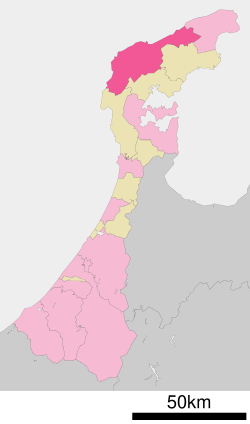Wajima, Ishikawa
|
Wajima 輪島市 |
||
|---|---|---|
| City | ||
|
||
 Location of Wajima in Ishikawa Prefecture |
||
| Location in Japan | ||
| Coordinates: 37°23′N 136°54′E / 37.383°N 136.900°ECoordinates: 37°23′N 136°54′E / 37.383°N 136.900°E | ||
| Country | Japan | |
| Region | Chūbu (Hokuriku) | |
| Prefecture | Ishikawa Prefecture | |
| Government | ||
| • Mayor | Fumiaki Kaji | |
| Area | ||
| • Total | 426.25 km2 (164.58 sq mi) | |
| Population (January 2008) | ||
| • Total | 31,532 | |
| • Density | 74/km2 (190/sq mi) | |
| Time zone | Japan Standard Time (UTC+9) | |
| City hall address | 2-29 Futatsuyamachi, Wajima-shi, Ishikawa-ken 928-8525 |
|
| Website | www |
|
Wajima (輪島市 Wajima-shi?) is a city located in Ishikawa Prefecture, Japan. The city was founded on March 31, 1954.
As of 2008, the city has an estimated population of 31,532 and a population density of 74 persons per km². The total area is 426.25 km².
On February 1, 2006, the town of Monzen (from Hōsu District, and previously from Fugeshi District before March 1, 2005) was merged into Wajima.
Noto Airport serves Wajima.
On March 25, 2007, the 2007 Noto earthquake caused one death, injuries, and property damage in Wajima and other parts of Ishikawa Prefecture.
Wajima has a humid subtropical climate (Köppen climate classification Cfa) with very warm summers and cool winters. Precipitation is quite heavy throughout the year.
The town is known within Japan for its lacquerware, called Wajima-nuri (輪島塗). There are artifacts showing lacquer was used to decorate and strengthen a shrine door from the 14th century. Wajima-nuri uses a technique that is unique to the area, mixing a finely powdered mineral, jinoko, with the lacquer in the early stages of production. Jinoko adds extra durability to Wajima-nuri items. The rougher, earlier layers are then coated with more layers of finer lacquer, which is then polished to a lustrous shine, and often decorated with designs made of gold and other precious materials. The lacquer tree was once abundant in the area, but is now scarce and most of the lacquer used is imported from China.
...
Wikipedia


